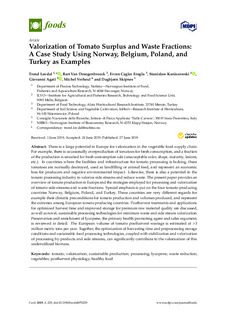| dc.contributor.author | Løvdal, Trond | |
| dc.contributor.author | van Droogenbroeck, Bart | |
| dc.contributor.author | Eroglu, Evren Caglar | |
| dc.contributor.author | Kaniszewski, Stanislaw | |
| dc.contributor.author | Agati, Giovanni | |
| dc.contributor.author | Verheul, Michel | |
| dc.contributor.author | Skipnes, Dagbjørn | |
| dc.coverage.spatial | Norway, Belgium, Poland, Turkey | nb_NO |
| dc.date.accessioned | 2019-07-10T07:52:59Z | |
| dc.date.available | 2019-07-10T07:52:59Z | |
| dc.date.created | 2019-07-04T10:35:34Z | |
| dc.date.issued | 2019-06-27 | |
| dc.identifier.citation | Foods. 2019, 8 (7), . | nb_NO |
| dc.identifier.issn | 2304-8158 | |
| dc.identifier.uri | http://hdl.handle.net/11250/2603989 | |
| dc.description.abstract | There is a large potential in Europe for valorization in the vegetable food supply chain.
For example, there is occasionally overproduction of tomatoes for fresh consumption, and a fraction
of the production is unsuited for fresh consumption sale (unacceptable color, shape, maturity, lesions,
etc.). In countries where the facilities and infrastructure for tomato processing is lacking, these
tomatoes are normally destroyed, used as landfilling or animal feed, and represent an economic
loss for producers and negative environmental impact. Likewise, there is also a potential in the
tomato processing industry to valorize side streams and reduce waste. The present paper provides an
overview of tomato production in Europe and the strategies employed for processing and valorization
of tomato side streams and waste fractions. Special emphasis is put on the four tomato-producing
countries Norway, Belgium, Poland, and Turkey. These countries are very di erent regards for
example their climatic preconditions for tomato production and volumes produced, and represent
the extremes among European tomato producing countries. Postharvest treatments and applications
for optimized harvest time and improved storage for premium raw material quality are discussed,
as well as novel, sustainable processing technologies for minimum waste and side stream valorization.
Preservation and enrichment of lycopene, the primary health promoting agent and sales argument,
is reviewed in detail. The European volume of tomato postharvest wastage is estimated at >3
million metric tons per year. Together, the optimization of harvesting time and preprocessing storage
conditions and sustainable food processing technologies, coupled with stabilization and valorization
of processing by-products and side streams, can significantly contribute to the valorization of this
underutilized biomass. | nb_NO |
| dc.language.iso | eng | nb_NO |
| dc.rights | Navngivelse 4.0 Internasjonal | * |
| dc.rights.uri | http://creativecommons.org/licenses/by/4.0/deed.no | * |
| dc.subject | Tomato surplus | nb_NO |
| dc.title | Valorization of Tomato Surplus and Waste Fractions: A Case Study Using Norway, Belgium, Poland, and Turkey as Examples | nb_NO |
| dc.type | Journal article | nb_NO |
| dc.type | Peer reviewed | nb_NO |
| dc.description.version | publishedVersion | nb_NO |
| dc.rights.holder | © 2019 by the authors. | nb_NO |
| dc.subject.nsi | VDP::Landbruks- og Fiskerifag: 900::Landbruksfag: 910::Planteforedling, hagebruk, plantevern, plantepatologi: 911 | nb_NO |
| dc.source.pagenumber | 21 | nb_NO |
| dc.source.volume | 8 | nb_NO |
| dc.source.journal | Foods | nb_NO |
| dc.source.issue | 7 | nb_NO |
| dc.identifier.doi | 10.3390/foods8070229 | |
| dc.identifier.cristin | 1710033 | |
| dc.relation.project | Norges forskningsråd: 238207 | nb_NO |
| dc.relation.project | Norges forskningsråd: 255613 | nb_NO |
| dc.relation.project | Norges forskningsråd: 284235 | nb_NO |
| cristin.unitcode | 7677,1,0,0 | |
| cristin.unitname | Divisjon for matproduksjon og samfunn | |
| cristin.ispublished | true | |
| cristin.fulltext | original | |
| cristin.qualitycode | 1 | |

